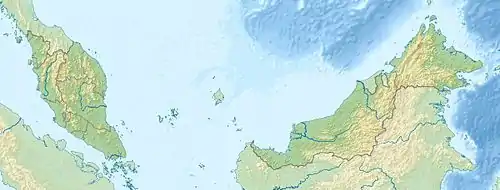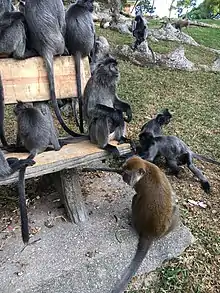Bukit Malawati
Bukit Malawati (Malawati Hill in English) is a hillfort located in Kuala Selangor, Selangor, Malaysia.[1] Managed by the Kuala Selangor Municipal Council, Bukit Malawati is a popular local tourist attraction.[2] The hillfort's position holds strategic importance which sits at the river mouth of Selangor River that drains into the Strait of Malacca, with a vantage point of both the Strait and Sumatra, Indonesia. Some of Bukit Malawati's historical highlights include an old lighthouse, as well as the remains of Kota Malawati (Malay for Fort Malawati).[1][3][4] Bukit Malawati also serves as the final resting place for three of Selangor's earliest Sultans.
| Bukit Malawati | |
|---|---|
 Bukit Malawati Location in Malaysia | |
| Highest point | |
| Coordinates | 3°20′31″N 101°14′46″E |
| Naming | |
| English translation | Malawati Hill |
| Language of name | Malay |
| Geography | |
| Location | Kuala Selangor District, Selangor |
| Geology | |
| Mountain type | Inselberg |
History
The fort was first constructed by local Malays in the early 16th century at the behest of Tun Mahmud Shah of Malacca. Towards the end of the 17th century, Bugis settlers began to establish themselves in the West coast of the Malay Peninsula and installed Raja Lumu to be the first Sultan of Selangor in 1742, who styled himself as Sultan Salehuddin Shah. Sultan Ibrahim Shah, who succeeded Raja Lumu in 1778, had the fort further fortified as precautionary measures to defend against possible Dutch invasions. Nonetheless, Kuala Selangor still fell to the Dutch troops when they stormed the fort in 1784. Led by Dirk van Hogendorp, the fierce campaign was mounted as reprisal to the series of assaults waged by Sultan Ibrahim's ally, Raja Haji Fisabilillah, against A Famosa in Malacca, which was a Dutch stronghold at the time. Although Raja Haji was killed during the battle, the Dutch wanted retribution from Sultan Ibrahim Shah for providing him with naval support. The Dutch East India Company (VOC) then dispatched their fleet of vessels to Kuala Selangor to attack Sultan Ibrahim Shah. The advancing van Hogendorp's VOC armada battered the fort with their cannons from water for two weeks, driving Sultan Ibrahim Shah's forces into the nearby jungles. Sultan Ibrahim Shah himself fled to Bernam, and subsequently to Pahang. Following his flight, the Dutch captured the fort and renamed it Fort Altingburg in honour of Willem Arnold Alting, the Governor-General of the Dutch East Indies from 1780 to 1797. Later, Sultan Ibrahim would return to recapture the fort in 1785 with the aid of his brother, Dato' Penggawa Permatang Mahabijaya (Penggawa Tua), and Bendahara Adb. The fort was eventually destroyed during the Selangor Civil War.[3][5]
Features
Bukit Malawati is located near other tourist attractions, such as Kampung Kuantan Firefly Park and Kuala Selangor Nature Park.[1][5] Some of the popular attractions at the hillfort also include a tram ride, a royal mausoleum, and a museum.[1][4]

Rumah Api Kuala Selangor (Kuala Selangor Lighthouse)
Also known as the Altingsburgh Lighthouse, the structure was originally built by the Dutch in 1794. It was extensively refurbished by the British in 1907 before it was officially reopened in 1910. The fully-functional lighthouse is now considered to be one of Bukit Malawati's defining features. Measuring at 83 metres from seabed and 27 metres from land, the lighthouse presently operates on electricity. It rotates and projects an intense beam of light that is visible up to 56 kilometres twice at every 15 seconds.
Batu Hampar (The Bedrock)
Measuring at 5x5x1 square feet, Batu Hampar is a large rock slab that was placed in the west of the courtyard. The bedrock was reportedly used for the purpose of executions, where traitors of the Sultan would be laid by their executioners for beheading. According to a local legend, the fourth Sultan of Selangor, Sultan Abdul Samad, would spend his evenings ruminating on the slab while watching the sunset.

Kota Malawati (Malawati Fort)
Cannons reinforced the ring of fortifications that encircled the fort, which was constructed by local villagers during the second Sultan of Selangor, Sultan Ibrahim Shah's rule in the 18th century.
Kuala Selangor Historical Museum
Not too far from the lighthouse, the local museum houses arrays of ancient weapons, dioramas, specimens of old currencies, and other collections of relics and artifacts. Visitors can learn about Kuala Selangor's local history, including its early settlement, fishing culture, and trading history from the exhibits.
Perigi Beracun (Poisoned Well)
Local history claimed that the Poisoned Well was used to torture traitors. Offenders would be placed inside the well, which would be filled with watery solution mixed with irritants, such as latex and bamboo shoots, up to chin-level as punishment. Today, curious visitors may view the well at close range, which has been covered with iron grates for health and safety to prevent unwanted mishaps.
Royal Mausoleum
The Royal Mausoleum (Malay: Makam Diraja Bukit Melawati) serves as the burial ground for the first three Sultans of Selangor - Sultan Salehuddin Shah, Sultan Ibrahim Shah, and Sultan Muhammad Shah, as well as their wives. The site is closed to the general public.
List of graves
Sultan graves
- Sultan Salehuddin Shah ibni Almarhum Raja Daeng Cherlak - the first Sultan of Selangor (died:1778)
- Sultan Ibrahim Shah ibni Almarhum Sultan Salehuddin Shah - (died:27 October 1826)
- Sultan Muhammad Shah ibni Almarhum Sultan Ibrahim Shah - (6 January 1857)
Tengku Ampuan/Pemaisuri graves (Graves of Royal Consorts)
- Che' Puan Besar Long Jalijah binti Dato' Husain -The first ever Che' Puan Besar of Selangor 1771 - ?
- Tengku Ampuan Tengah binti Raja Haji-The first Tengku Ampuan of Selangor 1796 - 27 October 1826
- Tengku Ampuan Basik binti Arung To' Mojong- Tengku Ampuan of Selangor ? - 6 January 1857
- Tengku Ampuan Aftah Binti Al-Marhum Sultan Muhammad Shah-Tengku Ampuan of Selangor 1844 - 1873
Royal family graves
- Raja Nyallar Shah ibni Almarhum Sultan Salehhuddin Shah - (Raja Muda) (died; 18ee)
- Raja Pyunnuh binti Almarhum Sultan Sallehhuddin Shah - (died; 18ee)
- Raja Pherrak binti Almarhum Sultan Sallehhuddin Shah - (died; 18ee)
- Raja Sharifah binti Almarhum Sultan Sallehhuddin Shah - (died; 18ee)
- Raja Ismail Shah ibni Almarhum Sultan Ibrahim Shah I - (died; 18ee)
- Raja Abbu Saidd Shah ibni Almarhum Sultan Ibrahim Shah I - (died; 18ee)
- Raja Abdullah Shah ibni Almarhum Sultan Ibrahim Shah I - (Raja Panglima Besar) (died; 18ee)
- Raja Ahmadd Shah ibni Almarhum Sultan Ibrahim Shah I - (died; 18ee)
- Raja Hassan Shah ibni Almarhum Sultan Ibrahim Shah I - (Raja Panglima Perang) (died; 18ee)
- Raja Hussin Shah ibni Almarhum Sultan Ibrahim Shah I - (died; 18ee)
- Raja Abdul Rahman Shah ibni Almarhum Sultan Ibrahim Shah I - (died; 18ee)
- Raja Hussin Shah ibni Almarhum Sultan Ibrahim Shah I - (died; 18ee)
- Raja Hanji Shah ibni Almarhum Sultan Ibrahim Shah I - (died; 18ee)
- Raja Yussuf Shah ibni Almarhum Sultan Ibrahim Shah I - (died; 18ee)
- Raja Abbas Shah I ibni Almarhum Sultan Ibrahim Shah I - (died; 18ee)
- Raja Salleh Shah ibni Almarhum Sultan Ibrahim Shah I - (died; 18ee)
- Raja Fattimmah binti Almarhum Sultan Ibrahim Shah I - (died; 18ee)
- Raja Sannyie binti Almarhum Sultan Ibrahim Shah I - (died; 18ee)
- Raja Ammyinnah binti Almarhum Sultan Ibrahim Shah I - (died; 18ee)
- Raja Aissyahh binti Almarhum Sultan Ibrahim Shah I - (died; 18ee)
- Raja Marryiamm binti Almarhum Sultan Ibrahim Shah I - (died; 18ee)
- Raja Maimunnah binti Almarhum Sultan Ibrahim Shah I - (died; 18ee)
- Raja Kaddijjah binti Almarhum Sultan Ibrahim Shah I - (died; 18ee)
- Raja Hallijjah binti Almarhum Sultan Ibrahim Shah I - (died; 18ee)
- Raja hammiddah binti Almarhum Sultan Ibrahim Shah I - (died; 18ee)
- Raja Sulaiman Shah I ibni Almarhum Sultan Muhammad Shah - (Raja Muda) (died; 1818)
- Raja Mahmudd Shah ibni Almarhum Sultan Muhammad Shah - (Raja Muda) (died; 18ss)
- Raja Lautt Shah ibni Almarhum Sultan Muhammad Shah - (Raja Muda) (died; 18sss)
- Raja Abdul Jabbar Shah ibni Almarhum Sultan Muhammad Shah - (died; 18ee)
- Raja Abbhas Shah II ibni Almarhum Sultan Muhammad Shah - (died; 18ee)
- Raja Ibrahim Shah II ibni Almarhum Sultan Muhammad Shah - (died; 18ee)
- Raja Siti binti Almarhum Sultan Muhammad Shah - (died; 18ee)
- Raja Saleha binti Almarhum Sultan Muhammad Shah - (died; 18ee)
- Raja Linjah binti Almarhum Sultan Muhammad Shah - (died; 18ee)
- Raja Auyah binti Almarhum Sultan Muhammad Shah - (died; 18ee)
- Raja Sennai binti Almarhum Sultan Muhammad Shah - (died; 18ee)
- Raja Alfah binti Almarhum Sultan Muhammad Shah - (died; 18ee)
- Raja Perduh binti Almarhum Sultan Muhammad Shah - (died; 18ee)
Fauna
Bukit Malawati is home to the local silvered leaf monkeys and long-tailed macaques.[1][3][5][6] The silvered leaf monkeys at Bukit Malawati are accustomed to human presence, and are sometimes bold enough to approach visitors.[6] Tourists are discouraged from feeding the monkeys.
References
- "Bukit Malawati". visitselangor.com. Retrieved 31 August 2018.
- "Kuala Selangor Municipal Council". mdks.gov.my. Retrieved 9 February 2022.
- "Bukit Malawati - Kuala Selangor, Selangor Malaysia". JourneyMalaysia.com. Archived from the original on 1 September 2018. Retrieved 31 August 2018.
- Rajendra, Edward. "Abandoned facilities in Kota Malawati disappoint visitors". Star Media Group. Retrieved 31 August 2018.
- Leong, Ewe Paik (2017). "More than fireflies in Kuala Selangor". New Straits Times. Retrieved 31 August 2018.
- Md. Zain, Badrul Munir; Mohd. Daut, Norlinda & Md. Nor, Shukor (2009–2010). "Characterizing Silvered Leaf Monkey–Visitor Interactions at Bukit Malawati, Kuala Selangor, Malaysia" (PDF). The Journal of Wildlife and Parks. 26: 83–94. Retrieved 1 September 2018.